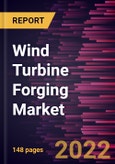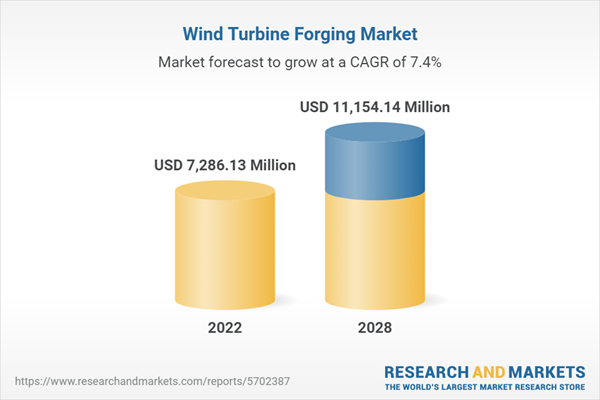The wind turbine forging market is expected to grow from US$ 7,286.13 million in 2022 to US$ 11,154.14 million by 2028; it is estimated to grow at a CAGR of 7.4% from 2022 to 2028.
Computer-aided engineering (CAE) is gaining rapid adoption in forging, a manufacturing process that produces the desired shape of a component by applying impact load on the metal. The use of CAE technology in the forging industry has significantly reduced the lead time and errors during product manufacturing. Small and medium-scale industries are adopting CAE technology to help in the forging of blades for turbine applications. It has a cost-effective interface and results in minimal failures during production, making the process more efficient. The CAE technology is highly applicable in the designing and manufacturing forged parts of wind turbines. In addition, many computer programs help predict the load, the optimum die design, and the best preform position before forging. Special purpose programs help with the numerical-control machining of forging parts.
CAE is playing a vital role in advancing the global wind energy sector by addressing harsh environmental conditions in the design phase. Advanced CAE software allows engineers to overcome many challenges regarding securing turbine platforms before construction. This streamlines the overall timeline of the project and ensures the long-term viability of these structures. The CAE technology provides innovative designs that maximize the efficiency of the turbines and enable wind towers to adjust reactively to capture wind at appropriate angles to maximize power. Integrating CAE technology with wind turbine forged parts during the manufacturing process increases effectiveness and lowers overall costs, which are expected to fuel the wind turbine forging market growth in the coming years.
The global wind turbine forging market is segmented into type and component. Based on type, the global wind turbine forging market is bifurcated into seamless rolled ring and open die forging. Based on component, the global wind turbine forging market is segmented into flanges, blades, bearings, gears, shafts, and others.
Scot Forge Co; Frisa Industrias SA de CV; Iraeta Energy Equipment Co Ltd; ULMA Forja S Coop; Celsa Armeringsstal AS; Bharat Forge Ltd; Specialty Ring Products Inc; Bruck GmbH; Tongyu Heavy Industry Co., Ltd; and Gerdau Summit Aços Fundidos e Forjados SA are among the key players operating in the wind turbine forging market. Several other market players were analyzed during this market research study to get a holistic view of the wind turbine forging market and its ecosystem. The wind turbine forging market size report provides detailed market insights, which helps the key players strategize their growth.
In 2022, the European renewable energy sector will be growing significantly, with countries such as Germany, Ireland, and Denmark producing 50% of the energy from wind energy. With the increase in energy demand across the region, the requirement for wind turbines is rapidly growing. This is offering growth perspectives to the players operating in the wind turbine forging market in Europe. According to the International Energy Agency (IEA), the installed offshore wind capacity is expected to grow largely due to falling costs, supportive governments, and technological advances. In September 2021, General Electric collaborated with Fraunhofer Institutes, one of Europe’s premier research organizations, and Voxeljet AG, the makers of huge sand binder jet printers, to design the world’s largest sand binder jet 3D printer for wind turbine components, called the Advance Casting Cell (ACC). The partnership aims to develop a machine that could print molds used for key turbine components measuring up to 9.5 m in diameter and up to 4 m in height. General Electric will supply the digital blueprints for the turbine parts the machine is required to print; Fraunhofer will do the research and development; and Voxeljet will handle the design, mechanical development, and creation of the prototype printers. Incorporating new technology for developing forged metal parts will lower costs and make the forging industry more sustainable by reducing its environmental impact.
The overall wind turbine forging market size has been derived using both primary and secondary sources. To begin the wind turbine forging market analysis research process, exhaustive secondary research has been conducted using internal and external sources to obtain qualitative and quantitative information related to the wind turbine forging market. The process also serves the purpose of obtaining an overview and forecast of the wind turbine forging market growth with respect to all market segments. Also, multiple primary interviews have been conducted with industry participants and commentators to validate the data and gain more analytical insights about the topic. Participants of this process include industry experts such as VPs, business development managers, market intelligence managers, and national sales managers - along with external consultants such as valuation experts, research analysts, and key opinion leaders - specializing in the market.
Computer-aided engineering (CAE) is gaining rapid adoption in forging, a manufacturing process that produces the desired shape of a component by applying impact load on the metal. The use of CAE technology in the forging industry has significantly reduced the lead time and errors during product manufacturing. Small and medium-scale industries are adopting CAE technology to help in the forging of blades for turbine applications. It has a cost-effective interface and results in minimal failures during production, making the process more efficient. The CAE technology is highly applicable in the designing and manufacturing forged parts of wind turbines. In addition, many computer programs help predict the load, the optimum die design, and the best preform position before forging. Special purpose programs help with the numerical-control machining of forging parts.
CAE is playing a vital role in advancing the global wind energy sector by addressing harsh environmental conditions in the design phase. Advanced CAE software allows engineers to overcome many challenges regarding securing turbine platforms before construction. This streamlines the overall timeline of the project and ensures the long-term viability of these structures. The CAE technology provides innovative designs that maximize the efficiency of the turbines and enable wind towers to adjust reactively to capture wind at appropriate angles to maximize power. Integrating CAE technology with wind turbine forged parts during the manufacturing process increases effectiveness and lowers overall costs, which are expected to fuel the wind turbine forging market growth in the coming years.
The global wind turbine forging market is segmented into type and component. Based on type, the global wind turbine forging market is bifurcated into seamless rolled ring and open die forging. Based on component, the global wind turbine forging market is segmented into flanges, blades, bearings, gears, shafts, and others.
Scot Forge Co; Frisa Industrias SA de CV; Iraeta Energy Equipment Co Ltd; ULMA Forja S Coop; Celsa Armeringsstal AS; Bharat Forge Ltd; Specialty Ring Products Inc; Bruck GmbH; Tongyu Heavy Industry Co., Ltd; and Gerdau Summit Aços Fundidos e Forjados SA are among the key players operating in the wind turbine forging market. Several other market players were analyzed during this market research study to get a holistic view of the wind turbine forging market and its ecosystem. The wind turbine forging market size report provides detailed market insights, which helps the key players strategize their growth.
Impact of COVID-19 Pandemic on Wind turbine forging Market
The COVID-19 pandemic stalled several wind energy-related programs and projects despite the remarkable progress made by the sector before 2020. However, from the second half of 2020, companies involved in developing wind turbine forged materials and components returned to their normal production and sales capacities. According to the Global Wind Energy Council, The global wind industry had a good year in 2021, with almost 94 GW of capacity added worldwide. Europe, South America, and the Middle East & Africa witnessed records for new onshore installations in 2021. The US, the UK, Spain, China, and India are among the countries with the highest installation of capacities. China accounted for 80% of offshore wind energy capacity added worldwide in 2021. Global net zero commitments and the renewed urgency for achieving energy security are anticipated to propel the number of wind turbine installations, boosting the demand for wind turbine forging.In 2022, the European renewable energy sector will be growing significantly, with countries such as Germany, Ireland, and Denmark producing 50% of the energy from wind energy. With the increase in energy demand across the region, the requirement for wind turbines is rapidly growing. This is offering growth perspectives to the players operating in the wind turbine forging market in Europe. According to the International Energy Agency (IEA), the installed offshore wind capacity is expected to grow largely due to falling costs, supportive governments, and technological advances. In September 2021, General Electric collaborated with Fraunhofer Institutes, one of Europe’s premier research organizations, and Voxeljet AG, the makers of huge sand binder jet printers, to design the world’s largest sand binder jet 3D printer for wind turbine components, called the Advance Casting Cell (ACC). The partnership aims to develop a machine that could print molds used for key turbine components measuring up to 9.5 m in diameter and up to 4 m in height. General Electric will supply the digital blueprints for the turbine parts the machine is required to print; Fraunhofer will do the research and development; and Voxeljet will handle the design, mechanical development, and creation of the prototype printers. Incorporating new technology for developing forged metal parts will lower costs and make the forging industry more sustainable by reducing its environmental impact.
The overall wind turbine forging market size has been derived using both primary and secondary sources. To begin the wind turbine forging market analysis research process, exhaustive secondary research has been conducted using internal and external sources to obtain qualitative and quantitative information related to the wind turbine forging market. The process also serves the purpose of obtaining an overview and forecast of the wind turbine forging market growth with respect to all market segments. Also, multiple primary interviews have been conducted with industry participants and commentators to validate the data and gain more analytical insights about the topic. Participants of this process include industry experts such as VPs, business development managers, market intelligence managers, and national sales managers - along with external consultants such as valuation experts, research analysts, and key opinion leaders - specializing in the market.
Table of Contents
1. Introduction
3. Research Methodology
4. Wind Turbine Forging Market Landscape
5. Wind Turbine Forging Market - Key Market Dynamics
6. Wind Turbine Forging Market - Global Market Analysis
7. Wind Turbine Forging Market - by Type
8. Wind Turbine Forging Market - by Component
9. Wind Turbine Forging Market - Geographic Analysis
10. Impact of COVID-19 Pandemic on Wind Turbine Forging Market
11. Industry Landscape
12. Company Profiles
13. Appendix
List of Figures
Companies Mentioned
- Scot Forge Co
- Frisa Industrias SA de CV
- Iraeta Energy Equipment Co Ltd
- ULMA Forja S Coop
- Celsa Armeringsstal AS
- Bharat Forge Ltd
- Specialty Ring Products Inc
- Tongyu Heavy Industry Co Ltd
- Gerdau Summit
- Bruck GMBH
Table Information
| Report Attribute | Details |
|---|---|
| No. of Pages | 148 |
| Published | December 2022 |
| Forecast Period | 2022 - 2028 |
| Estimated Market Value ( USD | $ 7286.13 Million |
| Forecasted Market Value ( USD | $ 11154.14 Million |
| Compound Annual Growth Rate | 7.4% |
| Regions Covered | Global |
| No. of Companies Mentioned | 10 |









